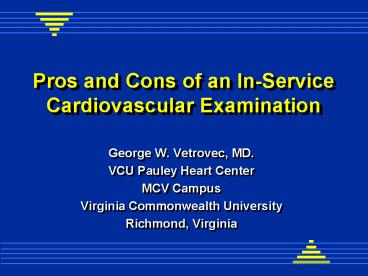Pros and Cons of an InService Cardiovascular Examination - PowerPoint PPT Presentation
1 / 26
Title:
Pros and Cons of an InService Cardiovascular Examination
Description:
What this is Not: A group of training directors writing a ' ... Requires extensive proctors/escorts to locally administer the exams. Cost - $90 per test taker. ... – PowerPoint PPT presentation
Number of Views:93
Avg rating:3.0/5.0
Title: Pros and Cons of an InService Cardiovascular Examination
1
Pros and Cons of an In-Service Cardiovascular
Examination
- George W. Vetrovec, MD.
- VCU Pauley Heart Center
- MCV Campus
- Virginia Commonwealth University
- Richmond, Virginia
2
Disclosures
- Member of the ABIM Cardiology Examination Board.
3
A Cardiology In Service ExamScope of the Issue
- What this is Not A group of training directors
writing a few questions a piece to make an
exam.
4
Pros and Cons
- Pros
- Measurement of Fellow progress.
- Identify trainee weaknesses early.
- Comparative training program quality.
- Satisfy ACGME Competency Outcomes Measures
- Cons
- Quality Questions.
- Psychometric Management.
- Comparative Exams
- Risk of teaching to an Exam.
- Cost.
5
Pros and Cons
- Pros
- Measurement of Fellow progress.
- Identify trainee weaknesses early.
- Comparative training program quality.
- Satisfy ACGME Competency Outcomes Measures
- Cons
- Quality Questions.
- Psychometric Management.
- Comparative Exams
- Risk of teaching to an Exam.
- Cost.
6
Pros and Cons
- Pros
- Measurement of Fellow progress.
- Identify trainee weaknesses early.
- Comparative training program quality.
- Satisfy ACGME Competency Outcomes Measures
- Cons
- Quality Questions.
- Psychometric Management.
- Comparative Exams
- Risk of teaching to an Exam.
- Cost.
7
Pros and Cons
- Pros
- Measurement of Fellow progress.
- Identify trainee weaknesses early.
- Comparative training program quality.
- Satisfy ACGME Competency Outcomes Measures.
- Cons
- Quality Questions.
- Psychometric Management.
- Comparative Exams
- Risk of teaching to an Exam.
- Cost.
8
Pros and Cons
- Pros
- Measurement of Fellow progress.
- Identify trainee weaknesses early.
- Comparative training program quality.
- Satisfy ACGME Competency Outcomes Measures
- Cons
- Quality Questions.
- Psychometric Management.
- Comparative Exams
- Risk of teaching to an Exam.
- Cost.
9
Writing a Good Question
- Testing point.
- Stem.
- Legitimate distracters.
- No negative or EXCEPT questions.
- No Multiple True False questions.
10
Pros and Cons
- Pros
- Measurement of Fellow progress.
- Identify trainee weaknesses early.
- Comparative training program quality.
- Satisfy ACGME Competency Outcomes Measures
- Cons
- Quality Questions.
- Psychometric Management.
- Comparative Exams
- Risk of teaching to an Exam.
- Cost.
11
Testing a Question
- Discrimination.
- Compare responses of top and low scorers.
- Difficulty.
- Relevance.
12
Pros and Cons
- Pros
- Measurement of Fellow progress.
- Identify trainee weaknesses early.
- Comparative training program quality.
- Satisfy ACGME Competency Outcomes Measures
- Cons
- Quality Questions.
- Psychometric Management.
- Comparative Exams
- Risk of teaching to an Exam.
- Cost.
13
Exam Reproducibility
- Exam reproducibility.
- Comparative multiple exams.
- Predictability for trainees future success.
- ABIM Certification.
- Practice competency.
14
Examination Security
- Where given.
- Proctors.
- Certainty of Test Taker identity.
15
Pros and Cons
- Pros
- Measurement of Fellow progress.
- Identify trainee weaknesses early.
- Comparative training program quality.
- Satisfy ACGME Competency Outcomes Measures
- Cons
- Quality Questions.
- Psychometric Management.
- Comparative Exams
- Risk of teaching to an Exam.
- Cost.
16
Pros and Cons
- Pros
- Measurement of Fellow progress.
- Identify trainee weaknesses early.
- Comparative training program quality.
- Satisfy ACGME Competency Outcomes Measures
- Cons
- Quality Questions.
- Psychometric Management.
- Comparative Exams
- Risk of teaching to an Exam.
- Cost.
17
Surmounting the ConsExamples from Other
Programs
18
Internal Medicine In Service Exam
- Owned by the American College of Physicians.
- Contract with the National Board of Medical
Examiners for psychometric support.
19
IM In Service Exam History of Exam
- Started in 1988.
- Evolved from the MKSAP Exam.
20
IM In Service Exam Magnitude of Exam
- 420 Programs 20,000 trainees.
- Two 3.5 hour exams.
- 4 Administrations per year.
- Requires extensive proctors/escorts to locally
administer the exams. - Cost - 90 per test taker.
- Financially self sustaining.
21
IM In Service Exam Structure
- Steering Committee.
- Writing Group.
- 8 Writers.
- Train Writers
- Contract with National Board of Medical Examiners
(USMLE)
22
IM In Service Exam Future Plans
- Make On line exam.
- 2-3 Years.
23
Other Models
- Pediatric Cardiology.
- American Board of Pediatrics.
- Connective Tissue.
- National Board of Medical Examiners
24
Cardiology In Service Exam Start up
- Organizing Group.
- Clinician test writers.
- Consulting Agency.
- Psychometrics.
- Test writing skills.
- Start up funding
25
A Cardiology In Service Exam Special
Considerations
- Images.
- Technical skill testing
26
A Cardiology In Service Exam Summary
- Feasible.
- Useful in evaluating trainee progress.
- Must be done well to achieve the benefits of such
an exam.































